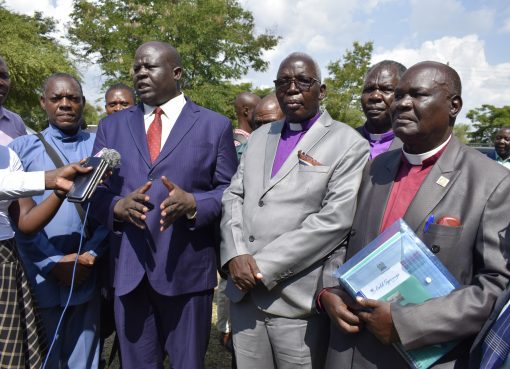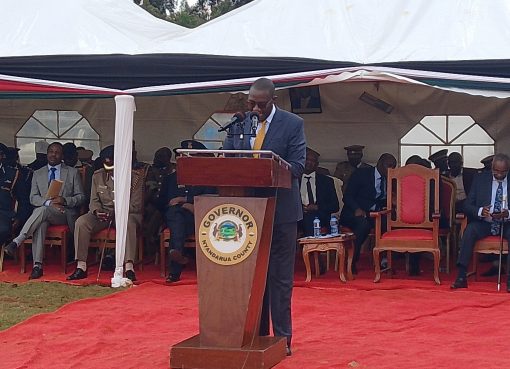Agricultural experts have opted for satellite data collection for timely, accurate, and reliable information to mitigate and counter the impact of climate change.
Scientists in the agricultural sector have embraced satellite technology for early warning systems to monitor and advise farmers on the ever-shifting seasonal climatic patterns to promote food security.
Assistant Director (Socio-Economics and Policy Development) at the Kenya Agricultural and Livestock Research Organization (KALRO) Dr. Wellington Mulinge stressed the need to change of tact in the wake of the global phenomenon attributed to extreme weather patterns including drought and floods.
He reiterated the importance to strengthen the science-policy interface for more effective, evidence-based intervention to facilitate the use of satellite data to spur agricultural production toward attaining a food-secure country.
Speaking during an end-of-information for agriculture and food security project meeting, Dr. Mulinge said the data offers early warning information by providing monitoring of crop conditions and performance through yield.
He regretted that the outdated traditional methods of drought prediction used in most of the rural areas of Kenya and in Africa were unreliable because they failed to take into account the explicit information on risk profiles and only offers a short-term forecast.

He however expressed fears that the limited technical capacity to analyze satellite data, lack of collaboration, and spatial resolutions among industry stakeholders were major hindrances to harnessing the benefits of satellite data in Kenya
Dr Mulinge said the Association for Strengthening Agricultural Research in Eastern and Central Africa (ASARECA) has been offering opportunities to stakeholders to receive continuous training on the use of satellite data, processing tools, products, and services.
“Adequate policy formulation to provide sustainable solutions now involves using geospatial data with other traditional information to identify challenges and opportunities,” he said.
Dr. Mulinge said Earth Observation (EO) data can be used in Policy Development in the Agriculture Sector such as zoning, early warning systems, yield estimates, agriculture statistics, and even climate change among others.
He said the use of the Earth Observation (EO) Data, he added, was important when identifying areas of food scarcity, tracking biodiversity and wildlife trends, measuring land use change, and even monitoring and responding to disasters such as floods, pest outbreaks, and health risks.
He insisted that the EO was vital in Evidence-Based Policy Development and decision making and it was time the government developed a strategic plan and framework to mainstream the EO data component for planning and implementation of agriculture-related programmes.
“There is need to create awareness at also continental level and economic blocks on the need to mainstream and leverage EO data in supporting the biennial review indicators in implementation of the Comprehensive Africa Agriculture Development Programme (CAADP) framework,” Dr. Mulinge said
Thylyn Kiptoo from Esri Eastern Africa, a leading Earth Observation data provider said they had established Africa Geoportal, which is an open-source data platform, as a sharing hub.
“The future of data science is the establishment of data hubs to enable collaboration and partnership. this however calls for establishment for working data sharing policy,” she said
Kiptoo noted that they have been working in partnership with the Regional Centre for Mapping of Resources for Development (RCMRD) Digital Earth Africa and Kenya Space Agency to scale up the utilization of EO data, products, and services.
Kenneth Mubea, of Digital Earth Africa, said they teamed up with ASARECA to implement the Information for Agriculture, Food and Water Security project to offer African countries access to satellite data for climate adaptation and mitigation, greater food security, and more sustainable development.
The project that has been running from July 2022 to June 2023 was being implemented in Eastern and Central Africa namely Kenya Ethiopia, Uganda, Rwanda Southern Africa, and Botswana.

“Following hands-on training on the use of DE Africa Platform and specific applications and responsible Institutions findings showed that there is a genuine interest in connecting to farmers as beneficiaries on tangible agricultural information such as crop type maps, yield estimates, water use requirements Something that farmers can relate to,” Mubea noted.
The move comes after Kenya launched its first operational earth observation satellite station earlier this year.
Named Taifa -1, the Nanosat was launched on board the SpaceX Falcon 9 rocket from the Vandenberg Space Force Base in California, United States of America.
Charles Mwangi, Ag. Director from the Kenya Space Agency said the nanosatellites that are 16m resolution panchromatic and 32m resolution multispectral imageries will be useful and will provide valuable information about the composition and condition of the earth’s surface.
“The insights gathered from the analysis of this data will provide useful information to policy and decision-makers in diverse fields who seek to address the challenges Kenya is facing,” he added.
Some of the challenges are food insecurity and dwindling agricultural production, caused by climate change effects such as prolonged drought and the nanosatellite will support in environmental monitoring, climate change monitoring and mitigation, food security through crop condition monitoring and crop yield estimation, disaster management, and natural resources management among others.
Sub-Saharan Africa economies spend between USD 30 to 50 billion per year importing food. Improving agriculture practices such as crop monitoring and correct pesticide use could boost domestic food production and enhance food security across the continent.
According to Digital Earth Africa, providing farmers with decision-ready data that helps them to optimize their sowing practices could help raise yearly production bringing benefits to the Africa Economy.
By Wangari Ndirangu




